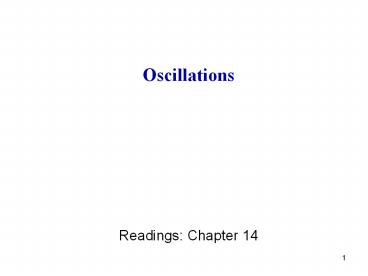Oscillations - PowerPoint PPT Presentation
Title:
Oscillations
Description:
Oscillations Readings: Chapter 14 * ... Net force: Oscillations about equilibrium position * The pendulum: ... Other titles: Arial Times New ... – PowerPoint PPT presentation
Number of Views:138
Avg rating:3.0/5.0
Title: Oscillations
1
Oscillations Readings Chapter 14
2
Oscillation Periodic Motion
T period of motion
- frequency
3
Oscillation Periodic Motion Simple Harmonic
Motion
Simple Harmonic Motion sinusoidal oscillation
or
The most general expression for sinusoidal motion
- phase constant
- amplitude
If then
4
Oscillation Periodic Motion Simple Harmonic
Motion
Example Uniform circular motion
x- component
- angular frequency
5
(No Transcript)
6
Oscillation Periodic Motion Simple Harmonic
Motion
T period of motion (units s)
- amplitude
- frequency (units hertz Hz 1/s)
- phase constant
- angular frequency (units rad/s)
7
- phase constant
Phase constant specifies the initial position of
the oscillator
8
Simple Harmonic Motion Position, Velocity, and
Acceleration
9
Simple Harmonic Motion object oscillating on a
spring
Newtons second law
Hookes law
10
Simple Harmonic Motion Conservation of energy
Kinetic energy
Potential energy
Total energy
11
(No Transcript)
12
Example Find the relation between kinetic and
potential energy at xA/3.
The total energy is the sum of kinetic and
potential energy. At xA the kinetic energy is
0.
At xA/3 the potential energy is
Then the kinetic energy at this point is
Then
13
Simple Harmonic Motion
If force is proportional to displacement (it is
not necessary the spring system) then
Solution of this equation
14
Oscillations about equilibrium position
Equilibrium
Net force
Oscillations about equilibrium position
15
The pendulum small-angle approximation
The net force is the sum of two forces tension
and gravitational force.
Tangential component of the net force is
If y is the arc length then
If yltltl then
then
16
If the system has a friction then there is an
energy loss
The energy is determined by the amplitude of
oscillations, so the energy loss means that the
amplitude is decreasing































